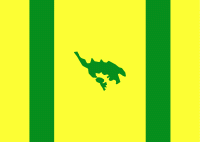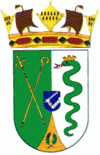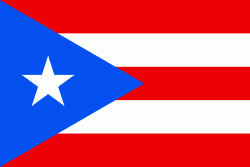Culebra (Culebra Municipio)
 |
 |
Originally called Isla del Pasaje and Isla de San Ildefonso, Culebra is also known as Isla Chiquita ("Little Island"), Cuna del Sol Borincano ("Cradle of the Puerto Rican Sun") and Última Virgen ("Last Virgin", due to its position at the end of the Virgin Islands archipelago).
Some sources claim that Christopher Columbus was the first European to arrive at the island during his second voyage on November 19, 1493. It is believed that the island was populated by Carib Indians during the colonization. After Agüeybaná and Agüeybaná II led the Taíno rebellion of 1511, Taíno Indians from the main island sought refuge on Culebra and allied with Caribs to launch random attacks at the island estates.
After that, the island was left abandoned for centuries. During the era of Spanish commerce through the Americas, it was used as a refuge for pirates, as well as local fishermen and sailors. Some sources mention a black overseer from British-ruled Tortola named John Stevens, who was put in charge of Culebra in the 1850s by the Governor of Vieques under the Spanish crown to protect the island from foreigners who, without proper permissions or payments of fees for despoiling Culebra, took fish, cut trees for lumber and prepared drift wood as charcoal for future sale elsewhere. Appropriating the unearned title of "Captain", he began a decades-long isolated sojourn on Culebra as enforcer of Spanish interests. In October 1871, however, Stevens was found dead outside his hut, his body viciously hacked apart. His heart and entrails had been placed in clay pots, in an apparent religious ritual to curse his soul. Spanish police from Vieques tracked down Tortolan foragers on Culebra who were suspected of the vicious murder. Eventually 21 of them were sentenced to forced labor on sugar plantations in Vieques as punishment. The affair caused an international incident, and, to satisfy demands from the British ambassador in Madrid, the Tortolans were finally freed by the Spanish Governor of Puerto Rico in July 1874. These events caused the government of Switzerland in June 1876 to recall an expedition destined for Culebra to establish a warm-weather sanatorium there. Fearing further foreign encroachments, the Spanish government decided to populate Culebra with its own subjects.
Culebra was then settled by Cayetano Escudero Sanz on October 27, 1880, when he completed his survey of the island that included subdivisions into usable lots. The Spanish government offered these parcels of land to anyone who would move to the island. The first settlers depended on rain for drinking water, as the island has no natural streams. Subsistence farming and cattle raising were established and a cistern was built for common use at one end of a natural harbor or Ensanada Honda in Spanish.
This first settlement was called San Ildefonso, to honor the Bishop of Toledo, officially San Ildefonso de la Culebra. Two years later, on September 25, 1882, construction of the Culebrita lighthouse began. It was completed on February 25, 1886 which made it the oldest operating lighthouse in the Caribbean until 1975, when the U.S. Navy and Coast Guard finally closed the facility.
Puerto Rico was ceded by Spain in the aftermath of the Spanish–American War under the terms of the Treaty of Paris of 1898 and became a territory of the United States.In 1899, the United States Department of War conducted a census of Puerto Rico finding that the population of Culebra was 704.
In 1902, Culebra was integrated as a part of Vieques. One year later, on June 26, President Theodore Roosevelt established the Culebra Naval Reservation. A bird refuge was established on February 27, 1909.
The United States Navy cited the 1900 Foraker Act to expropriate the land surrounding the natural harbor and in 1902 ordered the removal of all settlers so that a base for the South Atlantic fleet could be erected. Antonio Lugo Suarez, a Puerto Rican who had made his fortune in St. Thomas then part of the Danish West Indies and Pedro Márquez Morales, a Spaniard who had married a Puerto Rican woman from Vieques, were successful ranchers on Culebra. Each offered an alternate site to the displaced Culebrenses, so as to prevent the total abandonment of the island. The location identified by Márquez on Playa Sardinas became the town of Dewey.
A new church was built with materials taken from San Ildefonso and a customs office was constructed. Pedro Márquez (1850–1920) was appointed the first mayor under U.S. rule in 1905, replacing Leopoldo Padrón, the Special Delegate appointed for the transition from Spanish rule. Pedro Márquez was succeeded as mayor in 1912 by his son, Alejandro Márquez Laureano (1912–1914) who erected the first docks for the new town and installed electric lighting on the town's streets. He was succeeded as mayor in 1914 by Claro C. Feliciano, the first mayor who had been born in Culebra.
Map - Culebra (Culebra Municipio)
Map
Country - Puerto Rico
 |
 |
Currency / Language
| ISO | Currency | Symbol | Significant figures |
|---|---|---|---|
| USD | United States dollar | $ | 2 |
| ISO | Language |
|---|---|
| EN | English language |
| ES | Spanish language |















